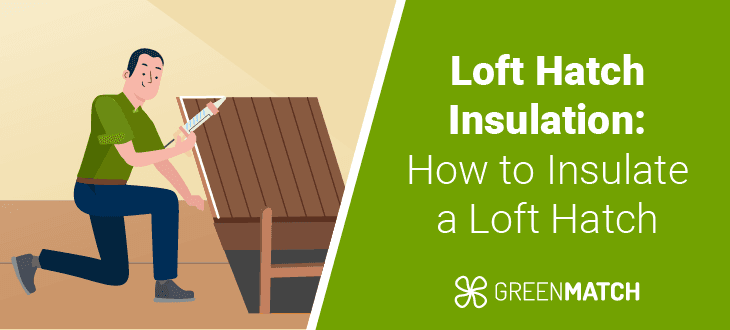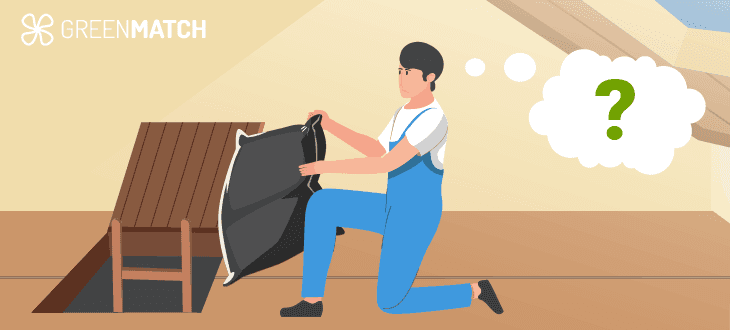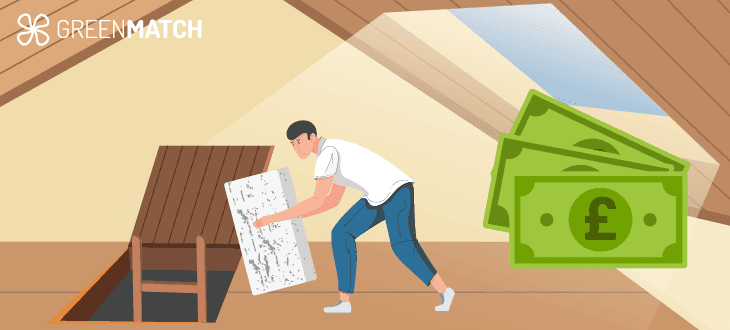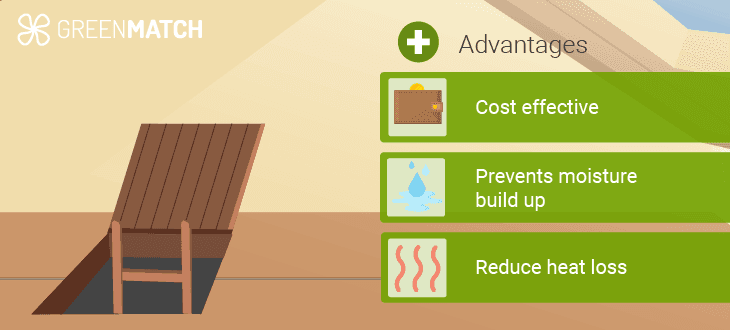Answer these simple questions and we will find you the BEST prices
Which type of solar quotes do you need?
It only takes 30 seconds
100% free with no obligation

Get Free quotes from insulation specialists near you

Save money by comparing quotes and choosing the most competitive offer

The service is 100% free and with no obligation
- GreenMatch
- Insulation
- Loft Insulation
- Loft Hatch Insulation
Loft Hatch Insulation: How to Insulate a Loft Hatch


- Insulating your loft hatch can potentially lower the U-value of your ceiling by as much as 20%, improving your home's thermal efficiency.
- The average cost to insulate a loft hatch is around £15, though prices can vary depending on the materials and methods you choose.
- Loft hatch insulation helps improve your home's air quality by preventing condensation and moisture buildup in both the loft and living spaces.
Insulation is vital in maintaining your home's energy efficiency, reducing energy bills, and lowering carbon emissions. While most people focus on insulating critical areas like the loft, walls, and floors, loft hatch insulation is often overlooked. However, this small area is a common point for heat loss, as air can pass from the eaves of your roof into the loft and escape through the hatch. This issue becomes even more pronounced if your loft is uninsulated.
Proper loft hatch insulation is a simple, cost-effective solution to prevent heat loss and enhance energy efficiency. Whether you're using a draught excluder, foam insulation, or specialised insulation boards, there are various methods to seal your loft hatch effectively.
In this guide, we’ll explore different insulation options, walk you through step-by-step instructions, discuss the benefits of insulating a loft hatch, and outline the associated costs, helping you keep warmth in and cold out.
Are you ready to insulate your loft hatch? Let GreenMatch UK handle the job for you! With our quick 30-second survey, you can receive up to four free, personalised quotes from our network of trusted professional installers in your area. Skip the hassle of researching and vetting contractors yourself and increase your chances of finding a great deal. Click below to get started!
- Describe your needs
- Get free quotes
- Choose the best offer
It only takes 30 seconds



How to insulate a loft hatch

Loft hatch insulation is relatively simple to obtain, but there are a few key considerations before starting. First, identify the type of loft hatch in your home. Older homes often have lift-out hatches, simple panels that can be lifted or removed. On the other hand, modern homes typically have hinged loft hatches that swing open like a door, offering easier access.
While the loft hatch insulation process is similar for both types, take extra care with hinged hatches to ensure the insulation doesn't interfere with the hinge mechanism.
Once you know your loft hatch type, gather the necessary tools, such as measuring tape, insulation material, a Stanley knife or saw, rubber tubing, super glue, a ladder, eye protection, and gloves.
Here are some common ways to approach loft hatch insulation:
- Installing insulation material: Use foam boards, mineral wool, or reflective foil to attach inside the hatch door. This method is highly effective but may cost more, with foam boards ranging from £10 to £21.50 per m2.
- Draught excluders: Strips or seals around the edges, handy for hinged hatches, to prevent draughts. Inexpensive at around £4.65 per m2 but doesn't insulate the hatch itself.
- Loft hatch cover: A pre-made cover that adds loft hatch insulation but is pricier, starting at £39.99.
- Insulation bag: An insulation bag is a large, flexible, and insulated cover designed to fit over the loft hatch and ladder, offering excellent thermal efficiency but is bulkier than other methods and starts at £14.65 per m2.
Each loft hatch insulation method offers different levels of effectiveness and cost, allowing you to choose based on your budget and needs.
How much does loft hatch insulation cost?

Loft hatch insulation is one of the most affordable ways to enhance your home's energy efficiency. Typically, installing rigid foam board insulation material costs around £15, although prices can vary depending on the materials and methods you choose. Below are the average costs for each insulation method:
| Insulation method | Average cost |
|---|---|
| Rigid foam boards | £10 to £21.50 per m2 |
| Mineral wool | £13 to £17.50 per m2 |
| Reflective foil | £4 to £38 per m2 |
| Draught excluder strips | £4.65 per m2 |
| Loft hatch cover | £39.99 or more |
| Insulation bag | £14.67 per m2 |
Loft hatch insulation is a great DIY loft insulation project for homeowners looking to reduce money on labour costs while improving energy efficiency. It's cost-effective and relatively simple to install with materials like insulation pillows or foam boards.
However, loft insulation companies come with added advantages. Professionals can help you avoid costly mistakes, such as gaps or improper insulation, that could lead to future repairs. Their expertise ensures the insulation is installed correctly, providing a more thorough and reliable solution and giving you peace of mind.
At GreenMatch, we make it easy by connecting you with top insulation installers in your area. Fill out our quick 30-second form, and we’ll provide up to four free quotes from the best insulation installers, saving you the hassle of researching. Click below to learn more!
- Describe your needs
- Get free quotes
- Choose the best offer
It only takes 30 seconds



Benefits of loft door insulation

Loft door insulation is essential for improving your home’s overall energy efficiency. An uninsulated loft hatch can be a significant source of heat loss, allowing warm air to escape into the loft and cold air to flow into your living spaces. This makes your home less comfortable and drives up your energy bills, as your heating system has to work harder to maintain the desired temperature. Additionally, an uninsulated loft hatch can lead to problems like condensation buildup, which can cause dampness or mould in your loft space—potentially leading to structural damage over time.
By installing loft hatch insulation, you create an effective barrier that helps prevent heat from escaping through the roof. This form of insulation for the roof is a cost-effective solution that works to keep your home warmer in winter and cooler in summer, improving year-round comfort. It can also significantly reduce your energy bills and, in some cases, lower the U-value of your ceiling by up to 20%. Lowering the U-value means your home retains heat more efficiently, leading to fewer draughts and a reduced carbon footprint, which benefits your home and the environment.
Insulating the loft hatch helps prevent moisture from accumulating in your loft. Without proper insulation, cold air meeting warm air can lead to condensation, which may result in damp patches or mould growth. Proper insulation minimises this risk, ensuring your loft remains dry and protected.
Loft hatch insulation is a simple yet highly effective way to address common problems like heat loss, draughts, and dampness while improving your home’s energy efficiency and comfort. It’s a worthwhile investment that pays off through reduced energy costs and a healthier living environment.
Is loft hatch insulation worth it?
Loft hatch insulation is a highly effective and inexpensive way to insulate a draughty area in your home. While it may seem like a small part of the overall insulation process, an uninsulated loft hatch can allow significant heat loss, making your home less energy-efficient and increasing energy bills. By insulating the loft hatch, you create a barrier that stops heat from escaping through the roof, which helps to maintain a comfortable temperature indoors and prevents cold draughts from entering your living space.
In addition to loft hatch insulation, you can consider other ways to improve your home’s energy efficiency, such as cold roof insulation or roof insulation. Cold roof insulation involves placing insulation between the ceiling joists to keep the living spaces below warmer, while traditional roof insulation is installed at the roof level to provide better overall thermal protection. Both methods can work alongside loft hatch insulation to create a more energy-efficient home.
While loft hatch insulation is relatively easy and affordable, opting for professional installation ensures that the job is done correctly and thoroughly. Professionals can seal gaps around the hatch, use the best materials, and prevent costly mistakes that might reduce insulation effectiveness. For a long-lasting and energy-efficient solution, professional installation is the best option.
At GreenMatch UK, we make it easy to find trusted professionals. Fill out our quick 30-second form, and we’ll provide you with up to four free quotes from local insulation installers, saving you time and effort. Get started today and make sure your home is insulated properly! Click below to learn more.
- Describe your needs
- Get free quotes
- Choose the best offer
It only takes 30 seconds



FAQ
Yes, you should insulate your loft hatch to prevent heat loss and improve your home’s energy efficiency.
To insulate a loft ladder hatch, attach insulation material such as foam boards or an insulation cover to the hatch door and seal any gaps around the edges.
To draught-proof a loft hatch, apply self-adhesive draught excluder strips around the edges to block airflow.
Use rigid foam boards, mineral wool, insulation bags, or reflective foil to effectively insulate an attic hatch.

Caoimhe is an experienced content writer and researcher who is passionate about providing accessible information to every reader. With a background in English literature and Sociology, she combines the two disciplines to create cohesive, well-thought-out, and well-informed pieces.
We strive to connect our customers with the right product and supplier. Would you like to be part of GreenMatch?

